Mites
There are several different types of mites which can infect your pet. They vary in their appearance and how much trouble they cause. This page takes you through the most common mites, their effects and how to treat them.
What are mites?
- Mites are insects, they are very small, most are too small to be seen with the naked eye. Some live on the skin but others burrow into it and can cause a very itchy reaction. They can infect all kinds of pets, cats, dogs & rabbits are all affected by mite infestations.
- Unlike other parasites, mites generally spend all of their lives on your pet, so they can only be passed by close contact between animals. They are generally slow crawlers and cannot jump like fleas.
- The most common mites found on our pets are;
Scabies Mite
- Scabies or ‘sarcoptic mange’ is caused by the mite Sarcoptes scabiei
- It is a burrowing mite and lives in the skin rather than on it, this means you cannot see it.
- It causes an intensely itchy rash, which can often become scabby and infected.
- The rash can occur anywhere but it is more often seen on the face, ears, armpits and groin.
- It is often called ‘Fox Mange’ as it is very common in foxes and can pass from them to dogs.
- Scarcoptic mange can be diagnosed by skin scrapes, but as it is so common, vets will generally just treat for it in animals with the right clinical signs
- It is easily treated with some veterinary spot-ons, which kill all the mites within 24 hours, but your pet may stay itchy for a few days, while the skin heals.
- Scabies can be passed to people, it generally forms small, red raised itchy spots on the arms and hands. If you are concerned, visit your GP.
- Cats can suffer from this condition but it is very rare.
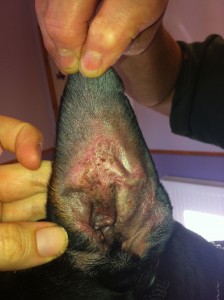
This dog’s ear has a scabies infestation. The skin is very sore, thickened and very itchy.
Demodex
- Demodex is a burrowing mite which is normally present in small numbers on most dogs.
- If it causes problems, it is generally in dogs less than a year old. If it occurs in older dogs, they may have an issue with their immune systems.
- The demodex mites lives in the hair follicles, too many will cause the hair to fall out and bald patches to form.
- Generally, it is not an itchy condition, which is where it differs from Scabies. However, if the skin becomes infected, your dog may become uncomfortable.
- It commonly occurs around the eyes and mouth, sometimes giving dogs the appearance of wearing ‘spectacles’!
- Demodex is diagnosed by skin scrapes and hair plucks.
- It can be treated by either veterinary spot-on treatments, by tablets or by bathing in a special wash. Sometimes a combination is needed to fully clear the infestation..
- Affected puppies are generally treated but they will often get rid of the problem themselves, but without treatment that can take several months
- Adult dogs which develop demodex will need investigating for underlying diseases.
- Bull breeds seem to be particularly susceptible to demodex infestations.
- Demodex can occur in cats, but it is very rare, and again, infected animals should be investigated for underlying disease.
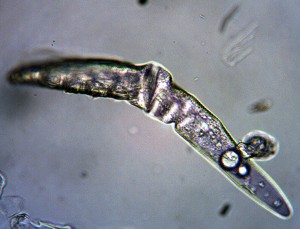
The Demodex mite is easily distinguishable under a microscope by it’s cigar shaped body
Ear Mites
- Ear mites, or ‘Otodectes cynotis’, live in your pets ear canals and can be very irritating
- Pets with ear mites will often shake their heads, scratch at their ears and have thick, black/brown wax in their ears
- Ear mites live their whole lives in your pets ears, and most animals will have them present in low numbers.
- Ear mites are easily sorted out with topical drops for the ears.
- It is important when you are treating ear mites to also use ear-cleaning drops. These will dissolve the ear wax and allow the medicated drops to work better.
- Ear mites cannot be passed to people.
- Some veterinary spot-on treatments will kill ear mites but are generally not strong enough when there is a bad infestation.
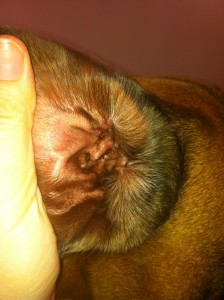
This ear is one with a typical ear infection. It is very inflamed and has a large black waxy discharge. Compare it to the normal ear below.
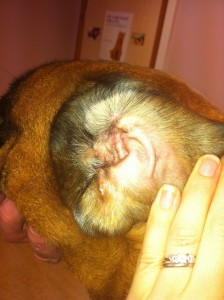
This is the other, unaffected, ear in the same dog. It is much less red and cleaner.
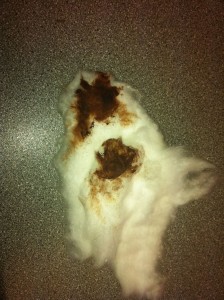
This is the typical black/brown waxy discharge that is seen in large quantities in ear mite infections.
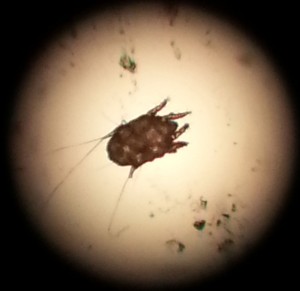
This is an ear mite as seen under a microscope. They are large enough to be seen by the naked eye but you have to watch carefully for them moving about!
Cheyletiella
- Cheyleteilla lives on the animals skin and in their coat and causes itching and a characteristic dandruff type flaking of the skin.
- Its common name is ‘walking dandruff’. If you remove some of the flakes from the animals coat and watch carefully, you may see some moving which is the mites.
- This mite is not common in cats and dogs, and the clinical signs are variable from mild scale in the coat, to widespread itchyness and scabs.
- Cheylettiella is a common parasite of rabbits and guniea pigs. Click here to learn more about them in these species.
- It can be treated with veterinary spot-ons and sprays, special washes, or occasionally injections.
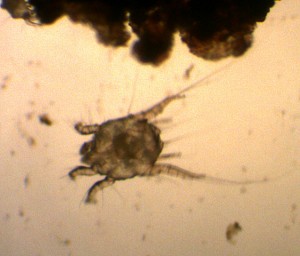
This is a Cheyletiella mite under a microscope. It is large enough to be seen with the naked eye, if you are patient enough!
Harvest mites
- Harvest mites or ‘Trombiculodis’ is a small orange mite that is more common around late summer.
- It can cause intensely itchy reactions on your pet, and is often found in small crevices, such as between the toes or in the folds of the ears.
- It is easily spotted as tiny orange dots on your pets skin
- It can be treated by using topical sprays
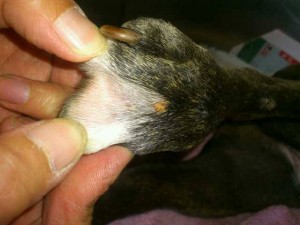
This is the typical appearance of harvest mites on a pet. They are bright orange, often cluster together and are commonly found between the toes or the folds in the ears.
Please note, this is an advice only website. If you have any specific queries about your pet, you should contact your vet.